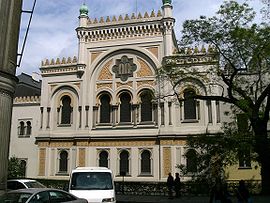
Spanish Synagogue
Encyclopedia

Moorish Revival
Moorish Revival or Neo-Moorish is one of the exotic revival architectural styles that were adopted by architects of Europe and the Americas in the wake of the Romanticist fascination with all things oriental...
synagogue built in Prague
Prague
Prague is the capital and largest city of the Czech Republic. Situated in the north-west of the country on the Vltava river, the city is home to about 1.3 million people, while its metropolitan area is estimated to have a population of over 2.3 million...
in 1868 to the design of Vojtěch Ignátz Ullmann. The facade copies the form of the Leopoldstädter Tempel
Leopoldstädter Tempel
The Leopoldstädter Tempel was the largest synagogue of Vienna, in the district of Leopoldstadt. It was also known as the Israelitische Bethaus in der Wiener Vorstadt Leopoldstadt. It was built in 1858 in a Moorish Revival style by the architect Ludwig Förster...
, built in Vienna
Vienna
Vienna is the capital and largest city of the Republic of Austria and one of the nine states of Austria. Vienna is Austria's primary city, with a population of about 1.723 million , and is by far the largest city in Austria, as well as its cultural, economic, and political centre...
, Austria
Austria
Austria , officially the Republic of Austria , is a landlocked country of roughly 8.4 million people in Central Europe. It is bordered by the Czech Republic and Germany to the north, Slovakia and Hungary to the east, Slovenia and Italy to the south, and Switzerland and Liechtenstein to the...
, in 1853, a tripartite facade with a tall central section flanked by lower wings on each side. As in Vienna, the central section is topped by a pair of domed turrets.
The synagogue is most remarkable for the elaborate style of the interior, every surface is covered by elaborate Islamic-style polychrome and gilded patterns, some painted and some carved or molded.
During the Second World War, the Germans used the building as a repository for property taken from the Jews. The building underwent a restoration in the late 1990s.
The building is owned by the Jewish Museum of Prague, and is used as a museum and concert hall.
Despite its name, the synagogue was never used by a Spanish
Spanish and Portuguese Jews
Spanish and Portuguese Jews are a distinctive sub-group of Sephardim who have their main ethnic origins within the Jewish communities of the Iberian peninsula and who shaped communities mainly in Western Europe and the Americas from the late 16th century on...
or Sephardic
Sephardi Jews
Sephardi Jews is a general term referring to the descendants of the Jews who lived in the Iberian Peninsula before their expulsion in the Spanish Inquisition. It can also refer to those who use a Sephardic style of liturgy or would otherwise define themselves in terms of the Jewish customs and...
congregation: it was in fact an early Reform
Reform Judaism
Reform Judaism refers to various beliefs, practices and organizations associated with the Reform Jewish movement in North America, the United Kingdom and elsewhere. In general, it maintains that Judaism and Jewish traditions should be modernized and should be compatible with participation in the...
temple. There are two theories to account for the synagogue's name.
- The Moorish architectural style may have been found reminiscent of the Golden age of Jewish culture in Spain.
- The synagogue was on the site of the city's most ancient synagogue, which may originally have been used by Byzantine JewsRomaniotesThe Romaniotes or Romaniots are a Jewish population who have lived in the territory of today's Greece and neighboring areas with large Greek populations for more than 2,000 years. Their languages were Yevanic, a Greek dialect, and Greek. They derived their name from the old name for the people...
. Some awareness of this fact may have given rise to the legend of a historic Sephardic community.

